New Insights into Crystallization of Heterophasic Isotactic Polypropylene by Fast Scanning Chip Calorimetry
Abstract
1. Introduction
2. Materials and Methods
2.1. Materials
2.2. Instrumentation
3. Results and Discussion
3.1. Nonisothermal Crystallization
3.2. Isothermal Crystallization
4. Conclusions
Author Contributions
Funding
Acknowledgments
Conflicts of Interest
References
- Natta, G.; Pino, P.; Corradini, P.; Danusso, F.; Mantica, E.; Mazzanti, G.; Moraglio, G. Crystalline high polymers of α-olefins. J. Am. Chem. Soc. 1955, 77, 1708–1710. [Google Scholar] [CrossRef]
- Natta, G.; Pasquon, I. The kinetics of stereospecific polymerization of olefins. Adv. Catal. 1959, 11, 1–68. [Google Scholar]
- Pasquini, N. Polypropylene Handbook; Hanser: Munich, Germany, 2005. [Google Scholar]
- Maddah, H.A. Polypropylene as a promising plastic: A review. Am. J. Polym. Sci. 2016, 6, 1–11. [Google Scholar]
- van der Wal, A.; Mulder, J.J.; Gaymans, R.J. Fracture of polypropylene: The effect of crystallinity. Polymer 1998, 39, 5477–5481. [Google Scholar] [CrossRef]
- Sugimoto, M.; Ishikawa, M.; Hatada, K. Toughness of polypropylene. Polymer 1995, 36, 3675–3682. [Google Scholar] [CrossRef]
- Gensler, R.; Plummer, C.J.G.; Grein, C.; Kausch, H.H. Influence of the loading rate on the fracture resistance of isotactic polypropylene and impact modified isotactic polypropylene. Polymer 2000, 41, 3809–3819. [Google Scholar] [CrossRef]
- Binsbergen, F.L.; de Lange, B.G.M. Morphology of polypropylene crystallized from the melt. Polymer 1968, 9, 23–40. [Google Scholar] [CrossRef]
- Bassett, D.C.; Olley, R.H. On the lamellar morphology of isotactic polypropylene spherulites. Polymer 1984, 25, 935–943. [Google Scholar] [CrossRef]
- Reinshagen, J.H.; Dunlap, R.W. The influence of structure and processing conditions on engineering mechanical properties in bulk crystallized isotactic polypropylene. J. Appl. Polym. Sci. 1976, 20, 9–24. [Google Scholar] [CrossRef]
- Castelein, G.; Coulon, G.; G’sell, C. Polymers under mechanical stress: Deformation of the nanostructure of isotactic polypropylene revealed by scanning force microscopy. Polym. Eng. Sci. 1997, 37, 1694–1701. [Google Scholar] [CrossRef]
- Zia, Q.; Radusch, H.J.; Androsch, R. Deformation behavior of isotactic polypropylene crystallized via a mesophase. Polym. Bull. 2009, 63, 755–771. [Google Scholar] [CrossRef]
- Wunderlich, B. Reversible crystallization and the rigid–amorphous phase in semicrystalline macromolecules. Progr. Polym. Sci. 2003, 28, 383–450. [Google Scholar] [CrossRef]
- Zia, Q.; Mileva, D.; Androsch, R. Rigid amorphous fraction in isotactic polypropylene. Macromolecules 2008, 41, 8095–8102. [Google Scholar] [CrossRef]
- Schawe, J.E. Mobile amorphous, rigid amorphous and crystalline fractions in isotactic polypropylene during fast cooling. J. Therm. Anal. Calor. 2017, 127, 931–937. [Google Scholar] [CrossRef]
- Menczel, J.D.; Jaffe, M. How did we find the rigid amorphous phase? J. Therm. Anal. Calor. 2007, 89, 357–362. [Google Scholar] [CrossRef]
- Varga, J. β-modification of isotactic polypropylene: Preparation, structure, processing, properties, and application. J. Macromol. Sci. Part B 2002, 41, 1121–1171. [Google Scholar] [CrossRef]
- Chen, H.B.; Karger-Kocsis, J.; Wu, J.S.; Varga, J. Fracture toughness of α-and β-phase polypropylene homopolymers and random-and block-copolymers. Polymer 2002, 43, 6505–6514. [Google Scholar] [CrossRef]
- Tordjeman, P.; Robert, C.; Marin, G.; Gerard, P. The effect of α, β crystalline structure on the mechanical properties of polypropylene. Eur. Phys. J. E 2001, 4, 459–465. [Google Scholar] [CrossRef]
- Aboulfaraj, M.; G’sell, C.; Ulrich, B.; Dahoun, A. In situ observation of the plastic deformation of polypropylene spherulites under uniaxial tension and simple shear in the scanning electron microscope. Polymer 1995, 36, 731–742. [Google Scholar] [CrossRef]
- Way, J.L.; Atkinson, J.R.; Nutting, J. The effect of spherulite size on the fracture morphology of polypropylene. J. Mater. Sci. 1974, 9, 293–299. [Google Scholar] [CrossRef]
- Chan, C.M.; Wu, J.; Li, J.X.; Cheung, Y.K. Polypropylene/calcium carbonate nanocomposites. Polymer 2002, 43, 2981–2992. [Google Scholar] [CrossRef]
- Ibhadon, A.O. Fracture mechanics of polypropylene: Effect of molecular characteristics, crystallization conditions, and annealing on morphology and impact performance. J. Appl. Polym. Sci. 1998, 69, 2657–2661. [Google Scholar] [CrossRef]
- Jeon, K.; Palza, H.; Quijada, R.; Alamo, R.G. Effect of comonomer type on the crystallization kinetics and crystalline structure of random isotactic propylene 1-alkene copolymers. Polymer 2009, 50, 832–844. [Google Scholar] [CrossRef]
- Mileva, D.; Androsch, R.; Cavallo, D.; Alfonso, G.C. Structure formation of random isotactic copolymers of propylene and 1-hexene or 1-octene at rapid cooling. Eur. Polym. J. 2012, 48, 1082–1092. [Google Scholar] [CrossRef]
- Mileva, D.; Androsch, R.; Radusch, H.J. Effect of cooling rate on melt-crystallization of random propylene-ethylene and propylene-1-butene copolymers. Polym. Bull. 2008, 61, 643–654. [Google Scholar] [CrossRef]
- Gahleitner, M.; Jääskeläinen, P.; Ratajski, E.; Paulik, C.; Reussner, J.; Wolfschwenger, J.; Neißl, W. Propylene–ethylene random copolymers: Comonomer effects on crystallinity and application properties. J. Appl. Polym. Sci. 2005, 95, 1073–1081. [Google Scholar] [CrossRef]
- Mileva, D.; Zia, Q.; Androsch, R. Tensile properties of random copolymers of propylene with ethylene and 1-butene: Effect of crystallinity and crystal habit. Polym. Bull. 2010, 65, 623–634. [Google Scholar] [CrossRef]
- Poon, B.; Rogunova, M.; Hiltner, A.; Baer, E.; Chum, S.P.; Galeski, A.; Piorkowska, E. Structure and properties of homogeneous copolymers of propylene and 1-hexene. Macromolecules 2005, 38, 1232–1243. [Google Scholar] [CrossRef]
- Galli, P.; Danesi, S.; Simonazzi, T. Polypropylene based polymer blends: Fields of application and new trends. Polym. Eng. Sci. 1984, 24, 544–554. [Google Scholar] [CrossRef]
- Coppola, F.; Greco, R.; Martuscelli, E.; Kammer, H.W.; Kummerlowe, C. Mechanical properties and morphology of isotactic polypropylene/ethylene-propylene copolymer blends. Polymer 1987, 28, 47–56. [Google Scholar] [CrossRef]
- D’orazio, L.; Mancarella, C.; Martuscelli, E.; Polato, F. Polypropylene/ethylene-co-propylene blends: Influence of molecular structure and composition of EPR on melt rheology, morphology and impact properties of injection-moulded samples. Polymer 1991, 32, 1186–1194. [Google Scholar] [CrossRef]
- Tam, W.Y.; Cheung, T.; Li, R.K.Y. An investigation on the impact fracture characteristics of EPR toughened polypropylene. Polym. Test. 1996, 15, 363–380. [Google Scholar] [CrossRef]
- Liang, J.Z.; Li, R.K.Y. Rubber toughening in polypropylene: A review. J. Appl. Polym. Sci. 2000, 77, 409–417. [Google Scholar] [CrossRef]
- Galli, P. The reactor granule technology: A revolutionary approach to polymer blends and alloys. Macromol. Symp. 1994, 78, 269–284. [Google Scholar] [CrossRef]
- Li, R.; Zhang, X.; Zhao, Y.; Hu, X.; Zhao, X.; Wang, D. New polypropylene blends toughened by polypropylene/poly (ethylene-co-propylene) in-reactor alloy: Compositional and morphological influence on mechanical properties. Polymer 2009, 50, 5124–5133. [Google Scholar] [CrossRef]
- Fan, Z.Q.; Zhang, Y.Q.; Xu, J.T.; Wang, H.T.; Feng, L.X. Structure and properties of polypropylene/poly (ethylene-co-propylene) in-situ blends synthesized by spherical Ziegler–Natta catalyst. Polymer 2001, 42, 5559–5566. [Google Scholar] [CrossRef]
- Mahdavi, H.; Nook, M.E. Structure and morphology of a commercial high-impact polypropylene in-reactor alloy synthesized using a spherical Ziegler–Natta catalyst. Polym. Int. 2010, 59, 1701–1708. [Google Scholar] [CrossRef]
- Gahleitner, M.; Tranninger, C.; Doshev, P. Heterophasic copolymers of polypropylene: Development, design principles, and future challenges. J. Appl. Polym. Sci. 2013, 130, 3028–3037. [Google Scholar] [CrossRef]
- Wunderlich, B. Macromolecular Physics, Volume 2: Crystal Nucleation, Growth, Annealing; Academic Press: New York, NY, USA, 1976. [Google Scholar]
- Hoffman, J.D.; Davis, G.T.; Lauritzen, J.I. The rate of crystallization of linear polymers with chain folding. In Treatise on Solid State Chemistry; Springer: Boston, MA, USA, 1976; pp. 497–614. [Google Scholar]
- Toda, A.; Androsch, R.; Schick, C. Insights into polymer crystallization and melting from fast scanning chip calorimetry. Polymer 2016, 91, 239–263. [Google Scholar] [CrossRef]
- Brucato, V.; Piccarolo, S.; la Carrubba, V. An experimental methodology to study polymer crystallization under processing conditions. The influence of high cooling rates. Chem. Eng. Sci. 2002, 57, 4129–4143. [Google Scholar] [CrossRef]
- Jariyavidyanont, K.; Williams, J.L.; Rhoades, A.M.; Kühnert, I.; Focke, W.; Androsch, R. Crystallization of polyamide 11 during injection molding. Polym. Eng. Sci. 2018, 58, 1053–1061. [Google Scholar] [CrossRef]
- Rhoades, A.M.; Williams, J.L.; Wonderling, N.; Androsch, R.; Guo, J. Skin/core crystallinity of injection-molded poly (butylene terephthalate) as revealed by microfocus X-ray diffraction and fast scanning chip calorimetry. J. Therm. Anal. Calor. 2017, 127, 939–946. [Google Scholar] [CrossRef]
- Fischer, C.; Seefried, A.; Drummer, D. Crystallization and Component Properties of Polyamide 12 at Processing-Relevant Cooling Conditions. Polym. Eng. Sci. 2017, 57, 450–457. [Google Scholar] [CrossRef]
- de Santis, F.; Adamovsky, S.; Titomanlio, G.; Schick, C. Isothermal nanocalorimetry of isotactic polypropylene. Macromolecules 2007, 40, 9026–9031. [Google Scholar] [CrossRef]
- Androsch, R.; Schick, C. Crystal nucleation of polymers at high supercooling of the melt. Adv. Polym. Sci. 2015, 276, 257–288. [Google Scholar]
- Mileva, D.; Androsch, R. Effect of co-unit type in random propylene copolymers on the kinetics of mesophase formation and crystallization. Colloid Polym. Sci. 2012, 290, 465–471. [Google Scholar] [CrossRef]
- Schawe, J.E. Influence of processing conditions on polymer crystallization measured by fast scanning DSC. J. Therm. Anal. Calor. 2014, 116, 1165–1173. [Google Scholar] [CrossRef]
- Yokoyama, Y.; Ricco, T. Crystallization and morphology of reactor-made blends of isotactic polypropylene and ethylene-propylene rubber. J. Appl. Polym. Sci. 1997, 66, 1007–1014. [Google Scholar] [CrossRef]
- Cai, J.; Luo, R.; Lv, R.; He, Y.; Zhou, D.; Hu, W. Crystallization kinetics of ethylene-co-propylene rubber/isotactic polypropylene blend investigated via chip-calorimeter measurement. Eur. Polym. J. 2017, 96, 79–86. [Google Scholar] [CrossRef]
- Doshev, P.; Lohse, G.; Henning, S.; Krumova, M.; Heuvelsland, A.; Michler, G.; Radusch, H.J. Phase interactions and structure evolution of heterophasic ethylene–propylene copolymers as a function of system composition. J. Appl. Polym. Sci. 2006, 101, 2825–2837. [Google Scholar] [CrossRef]
- Brintzinger, H.H.; Fischer, D.; Mülhaupt, R.; Rieger, B.; Waymouth, R.M. Stereospecific olefin polymerization with chiral metallocene catalysts. Angew. Chem. Int. Ed. 1995, 34, 1143–1170. [Google Scholar] [CrossRef]
- Chum, P.S.; Swogger, K.W. Olefin polymer technologies—History and recent progress at The Dow Chemical Company. Progr. Polym. Sci. 2008, 33, 797–819. [Google Scholar] [CrossRef]
- Wang, J.; Doshev, P.; Resconi, L.; Toltsch, W. Heterophasic Polypropylene Polymer. EU. Patent EP 2,891,667 B1, 15 March 2017. [Google Scholar]
- Jariyavidyanont, K.; Abdelaziz, A.; Androsch, R.; Schick, C. Experimental analysis of lateral thermal inhomogeneity of a specific chip-calorimeter sensor. Thermochim. Acta 2019, 674, 95–99. [Google Scholar] [CrossRef]
- Wurm, A.; Herrmann, A.; Cornelius, M.; Zhuravlev, E.; Pospiech, D.; Nicula, R.; Schick, C. Temperature dependency of nucleation efficiency of carbon nanotubes in PET and PBT. Macromol. Mater. Eng. 2015, 300, 637–649. [Google Scholar] [CrossRef]
- Schawe, J.E.K.; Pogatscher, S. Material characterization by fast scanning calorimetry: Practice and applications. In Fast Scanning Calorimetry; Springer: Cham, Switzerland, 2016; pp. 3–80. [Google Scholar]
- Schick, C. Differential scanning calorimetry (DSC) of semicrystalline polymers. Anal. Bioanal. Chem. 2009, 395, 1589. [Google Scholar] [CrossRef]
- Höhne, G.; Hemminger, W.F.; Flammersheim, H.J. Differential Scanning Calorimetry; Springer: Berlin/Heidelberg, Germany, 2013. [Google Scholar]
- de Santis, F.; Adamovsky, S.; Titomanlio, G.; Schick, C. Scanning nanocalorimetry at high cooling rate of isotactic polypropylene. Macromolecules 2006, 39, 2562–2567. [Google Scholar] [CrossRef]
- Gradys, A.; Sajkiewicz, P.; Minakov, A.A.; Adamovsky, S.; Schick, C.; Hashimoto, T.; Saijo, K. Crystallization of polypropylene at various cooling rates. Mater. Sci. Eng. A 2005, 413, 442–446. [Google Scholar] [CrossRef]
- van Drongelen, M.; Meijer-Vissers, T.; Cavallo, D.; Portale, G.; Poel, G.V.; Androsch, R. Microfocus wide-angle X-ray scattering of polymers crystallized in a fast scanning chip calorimeter. Thermochim. Acta 2013, 563, 33–37. [Google Scholar] [CrossRef]
- Richardson, M.J.; Flory, P.J.; Jackson, J.B. Crystallization and melting of copolymers of polymethylene. Polymer 1963, 4, 221–236. [Google Scholar] [CrossRef]
- Baker, C.H.; Mandelkern, L. The crystallization and melting of copolymers I—The effect of the crystallization temperature upon the apparent melting temperature of polymethylene copolymers. Polymer 1966, 7, 7–21. [Google Scholar] [CrossRef]
- Baker, C.H.; Mandelkern, L. The crystallization and melting of copolymers II—variation in unit-cell dimensions in polymethylene copolymers. Polymer 1966, 7, 71–83. [Google Scholar] [CrossRef]
- Ruiz-De-Ballesteros, O.; Auriemma, F.; Guerra, G.; Corradini, P. Molecular organization in the pseudo-hexagonal crystalline phase of ethylene−propylene copolymers. Macromolecules 1996, 29, 7141–7148. [Google Scholar] [CrossRef]
- Androsch, R. In situ atomic force microscopy of the mesomorphic− monoclinic phase transition in isotactic polypropylene. Macromolecules 2008, 41, 533–535. [Google Scholar] [CrossRef]
- Mileva, D.; Androsch, R.; Zhuravlev, E.; Schick, C. Temperature of melting of the mesophase of isotactic polypropylene. Macromolecules 2009, 42, 7275–7278. [Google Scholar] [CrossRef]
- Androsch, R.; di Lorenzo, M.L.; Schick, C.; Wunderlich, B. Mesophases in polyethylene, polypropylene, and poly (1-butene). Polymer 2010, 51, 4639–4662. [Google Scholar] [CrossRef]
- Mileva, D.; Androsch, R.; Zhuravlev, E.; Schick, C.; Wunderlich, B. Isotropization, perfection and reorganization of the mesophase of isotactic polypropylene. Thermochim. Acta 2011, 522, 100–109. [Google Scholar] [CrossRef]
- Langhe, D.S.; Hiltner, A.; Baer, E. Transformation of isotactic polypropylene droplets from the mesophase into the α-phase. J. Polym. Sci. Polym. Phys. 2011, 49, 1672–1682. [Google Scholar] [CrossRef]
- Mileva, D.; Androsch, R.; Zhuravlev, E.; Schick, C.; Wunderlich, B. Homogeneous nucleation and mesophase formation in glassy isotactic polypropylene. Polymer 2012, 53, 277–282. [Google Scholar] [CrossRef]
- Zhao, J.; Wang, Z.; Niu, Y.; Hsiao, B.S.; Piccarolo, S. Phase transitions in prequenched mesomorphic isotactic polypropylene during heating and annealing processes as revealed by simultaneous synchrotron SAXS and WAXD technique. J. Phys. Chem. B 2012, 116, 147–153. [Google Scholar] [CrossRef]
- Schawe, J.E.K. Analysis of non-isothermal crystallization during cooling and reorganization during heating of isotactic polypropylene by fast scanning DSC. Thermochim. Acta 2015, 603, 85–93. [Google Scholar] [CrossRef]
- Mathot, V.B.F.; Scherrenberg, R.L.; Pijpers, M.F.J.; Bras, W. Dynamic DSC, SAXS and WAXS on homogeneous ethylene-propylene and ethylene-octene copolymers with high comonomer contents. J. Therm. Anal. 1996, 46, 681–718. [Google Scholar] [CrossRef]
- Eynde, S.V.; Mathot, V.; Koch, M.H.J.; Reynaers, H. Thermal behaviour and morphology of homogeneous ethylene–propylene and ethylene–1-butene copolymers with high comonomer contents. Polymer 2000, 41, 3437–3453. [Google Scholar] [CrossRef]
- Wunderlich, B. Macromolecular Physics, Vol. 3: Crystal Melting; Academic Press: New York, NY, USA, 1980. [Google Scholar]
- Schick, C.; Androsch, R.; Schmelzer, J.W.P. Homogeneous crystal nucleation in polymers. J. Phys. Cond. Matter 2017, 29, 453002. [Google Scholar] [CrossRef] [PubMed]
- Silvestre, C.; Cimmino, S.; Duraccio, D.; Schick, C. Isothermal crystallization of isotactic poly (propylene) studied by superfast calorimetry. Macromol. Rapid Comm. 2007, 28, 875–881. [Google Scholar] [CrossRef]
- Cavallo, D.; Mileva, D.; Portale, G.; Zhang, L.; Balzano, L.; Alfonso, G.C.; Androsch, R. Mesophase-mediated crystallization of poly (butylene-2, 6-naphthalate): An example of Ostwald’s rule of stages. ACS Macro Lett. 2012, 1, 1051–1055. [Google Scholar] [CrossRef]
- Androsch, R.; Soccio, M.; Lotti, N.; Jehnichen, D.; Göbel, M.; Schick, C. Enthalpy of formation and disordering temperature of transient monotropic liquid crystals of poly (butylene 2, 6-naphthalate). Polymer 2018, 158, 77–82. [Google Scholar] [CrossRef]
- Ding, Q.; Soccio, M.; Lotti, N.; Cavallo, D.; Androsch, R. Melt Crystallization of Poly (butylene 2,6-naphthalate). Chin. J. Polym. Sci. 2020, 38, 311–322. [Google Scholar] [CrossRef]
- Hsu, C.C.; Geil, P.H.; Miyaji, H.; Asai, K. Structure and properties of polypropylene crystallized from the glassy state. J. Polym. Sci. Polym. Phys. 1986, 24, 2379–2401. [Google Scholar] [CrossRef]
- Ogawa, T.; Miyaji, H.; Asai, K. Nodular structure of polypropylene. J. Phys. Soc. Jpn. 1985, 54, 3668–3670. [Google Scholar] [CrossRef]
- Zia, Q.; Androsch, R.; Radusch, H.-J.; Piccarolo, S. Morphology, reorganization and stability of mesomorphic nanocrystals in isotactic polypropylene. Polymer 2006, 47, 8163–8172. [Google Scholar] [CrossRef]
- Zia, Q.; Androsch, R.; Radusch, H.-J.; Ingoliç, E. Crystal morphology of rapidly cooled isotactic polypropylene: A comparative study by TEM and AFM. Polym. Bull. 2008, 60, 791–798. [Google Scholar] [CrossRef]
- Androsch, R.; Monami, A.; Kucera, J. Effect of an alpha-phase nucleating agent on the crystallization kinetics of a propylene/ethylene random copolymer at largely different supercooling. J. Cryst. Growth 2014, 408, 91–96. [Google Scholar] [CrossRef]
- Schawe, J.E.K.; Vermeulen, P.A.; van Drongelen, M. A new crystallization process in polypropylene highly filled with calcium carbonate. Colloid Polym. Sci. 2015, 293, 1607–1614. [Google Scholar] [CrossRef]
- Schawe, J.E.K.; Vermeulen, P.A.; van Drongelen, M. Two processes of α-phase formation in polypropylene at high supercooling. Thermochim. Acta 2015, 616, 87–91. [Google Scholar] [CrossRef]
- Androsch, R.; Rhoades, A.M.; Stolte, I.; Schick, C. Density of heterogeneous and homogeneous crystal nuclei in poly (butylene terephthalate). Eur. Polym. J. 2015, 66, 180–189. [Google Scholar] [CrossRef]
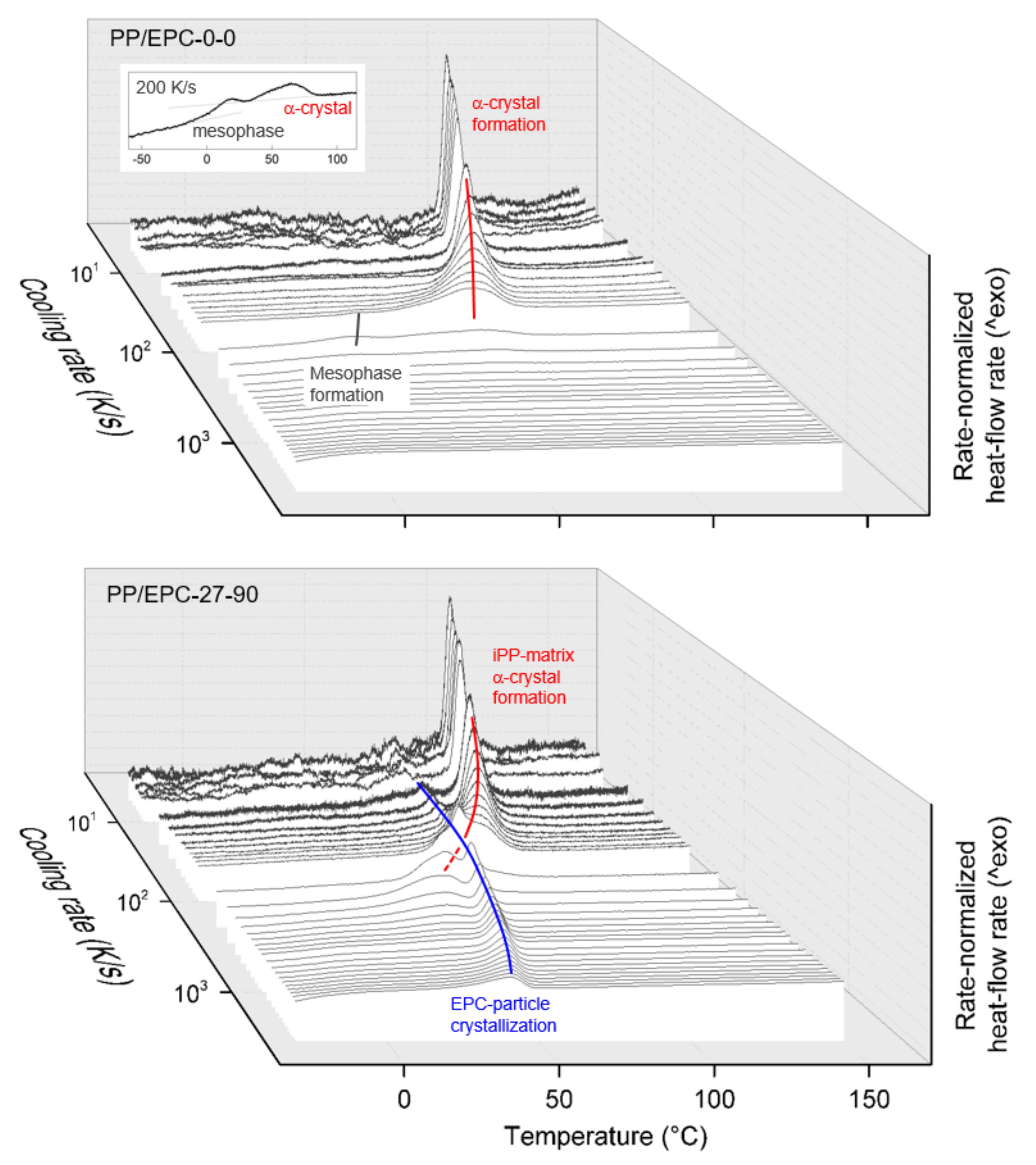
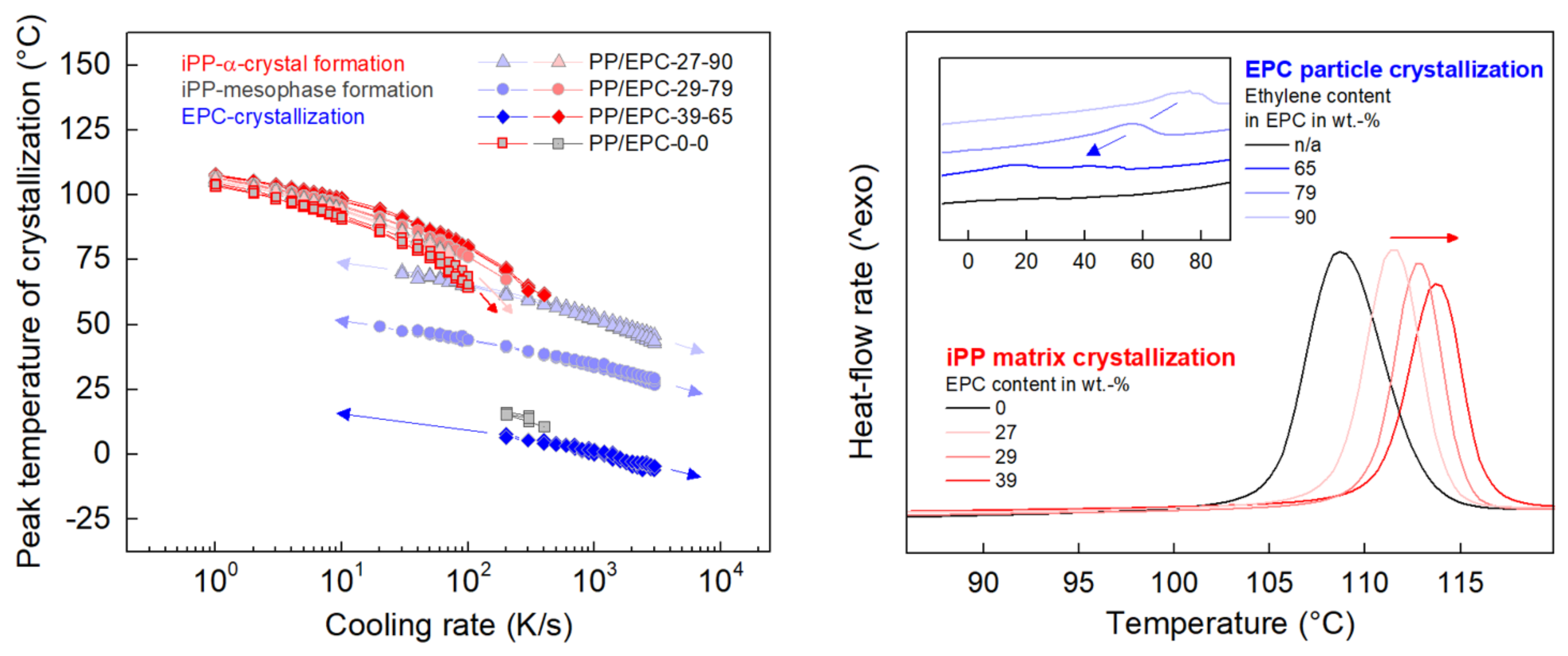

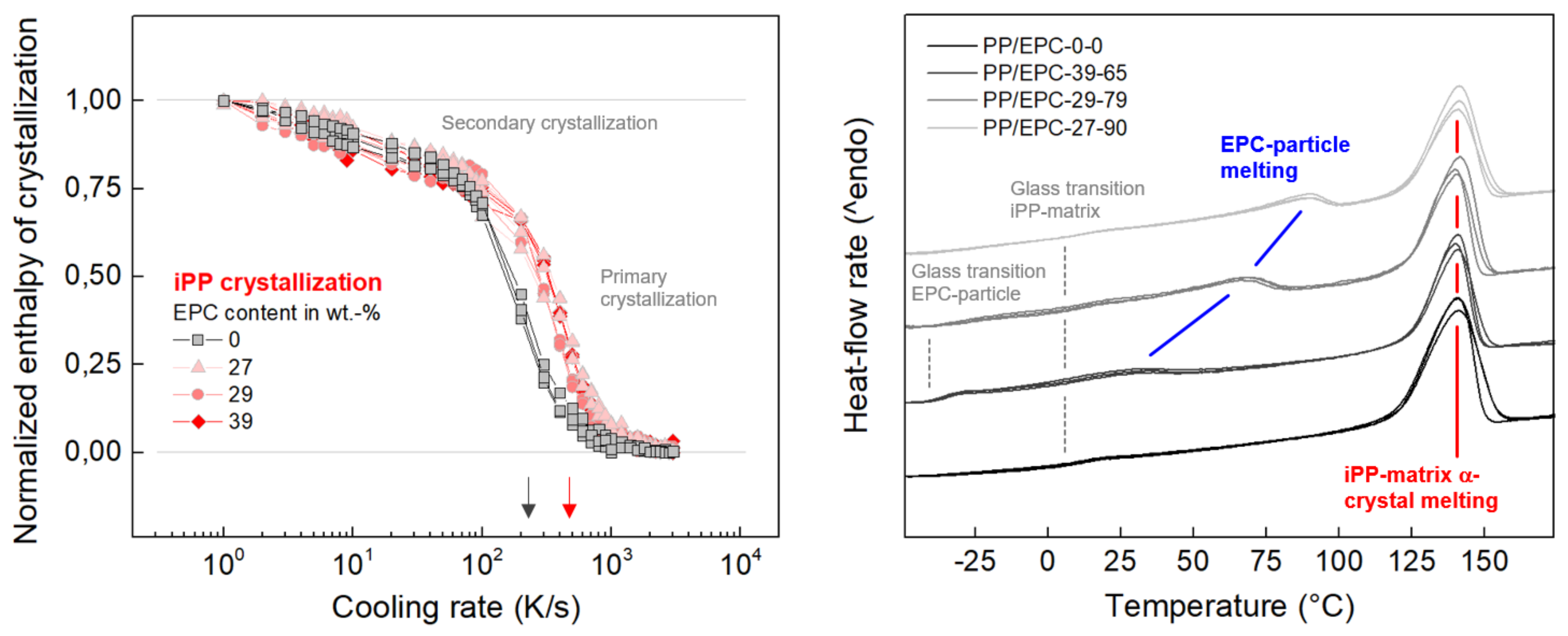
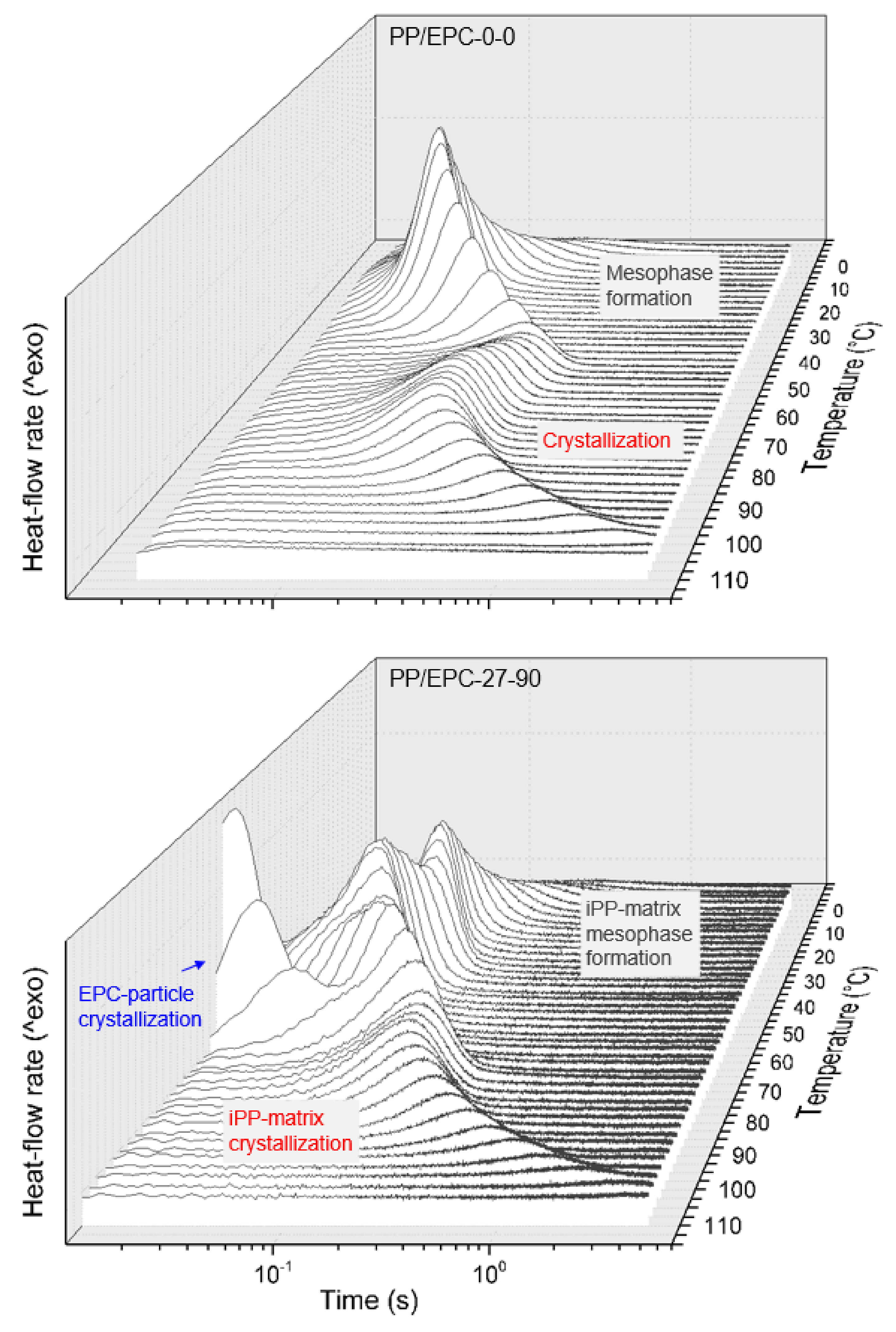
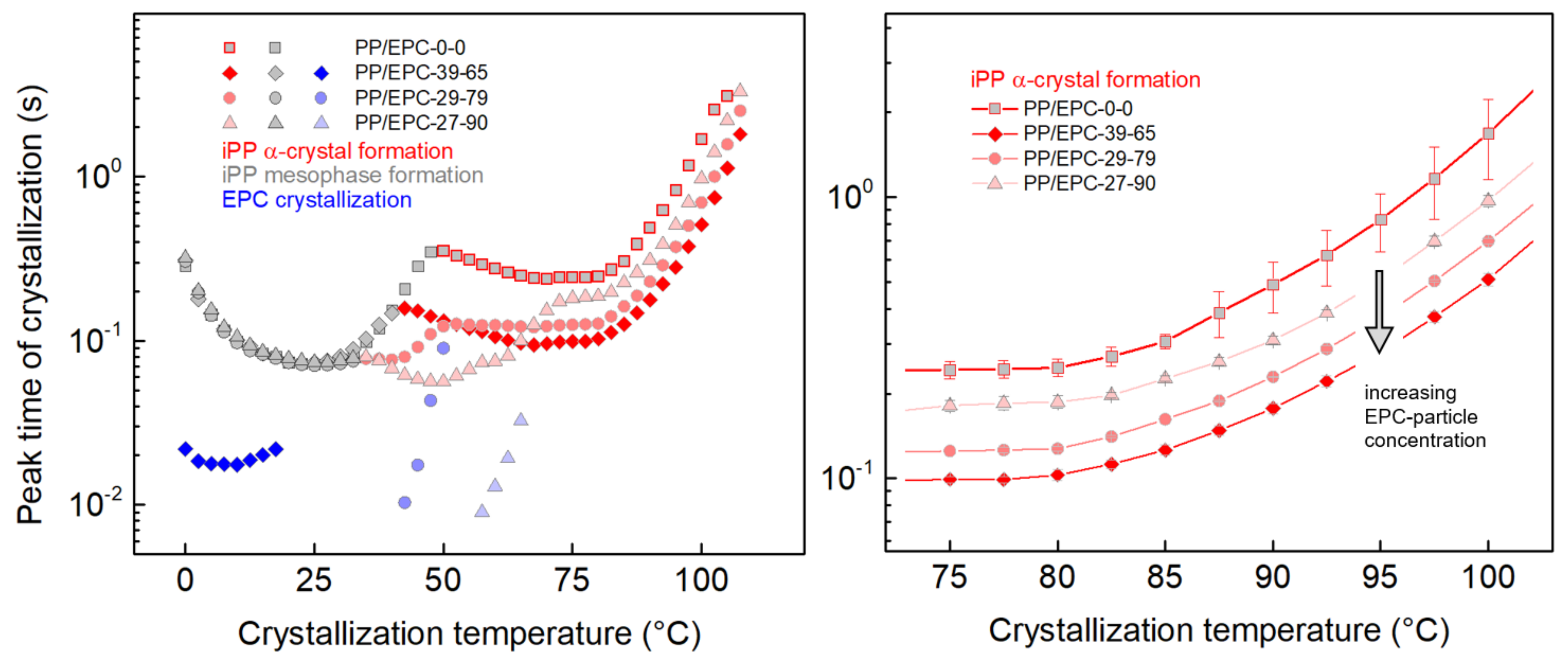
| Polymer | C2 (Total) 1 [wt %] | XCS 2 [wt %] | C2 (XCS) 3 [wt %] | IV (XCS) 4 [dL/g] | Matrix MFR 5 [g/(10 min)] |
|---|---|---|---|---|---|
| PP/EPC-0-0 | 0 | – | – | – | 35 |
| PP/EPC-27-90 | 23 | 27 | 90 | 0.91 | ~35 |
| PP/EPC-29-79 | 27 | 29 | 79 | 3.46 | ~35 |
| PP/EPC-39-65 | 25 | 39 | 65 | 2.26 | 80 |
© 2020 by the authors. Licensee MDPI, Basel, Switzerland. This article is an open access article distributed under the terms and conditions of the Creative Commons Attribution (CC BY) license (http://creativecommons.org/licenses/by/4.0/).
Share and Cite
Mileva, D.; Wang, J.; Gahleitner, M.; Jariyavidyanont, K.; Androsch, R. New Insights into Crystallization of Heterophasic Isotactic Polypropylene by Fast Scanning Chip Calorimetry. Polymers 2020, 12, 1683. https://doi.org/10.3390/polym12081683
Mileva D, Wang J, Gahleitner M, Jariyavidyanont K, Androsch R. New Insights into Crystallization of Heterophasic Isotactic Polypropylene by Fast Scanning Chip Calorimetry. Polymers. 2020; 12(8):1683. https://doi.org/10.3390/polym12081683
Chicago/Turabian StyleMileva, Daniela, Jingbo Wang, Markus Gahleitner, Katalee Jariyavidyanont, and René Androsch. 2020. "New Insights into Crystallization of Heterophasic Isotactic Polypropylene by Fast Scanning Chip Calorimetry" Polymers 12, no. 8: 1683. https://doi.org/10.3390/polym12081683
APA StyleMileva, D., Wang, J., Gahleitner, M., Jariyavidyanont, K., & Androsch, R. (2020). New Insights into Crystallization of Heterophasic Isotactic Polypropylene by Fast Scanning Chip Calorimetry. Polymers, 12(8), 1683. https://doi.org/10.3390/polym12081683





